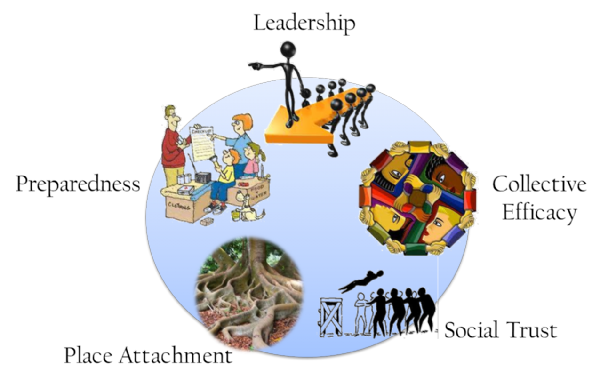Community resiliency is a term commonly used to describe the ability of a community to endure and survive crisis situations. It encompasses the community's adaptability to changing circumstances and its capability to respond effectively.
The community resiliency assessment project was launched in 2010 by Prof. Limor Aharonson-Daniel from Ben-Gurion University of the Negev and Prof. Mooli Lahad from Tel-Hai Academic College. Aharonson-Danidl and Lahad formed the Conjoint Community Resiliency Assessment Collaboration: a multidisciplinary cooperative network of experts from seven Israeli academic institutions, linked to decision-makers and partners from relevant ministries and emergency services.
The goal of this effort was to develop a tool that can provide Local and government authorities with a standard and scientifically valid assessment of their community's resilience in order to support the direction of resources towards the elements that the evaluation has pinpointed as needing a boost. Furthermore, the CCRAM facilitates the appraisal of the efficacy of the action taken.
In the past decade the CCRAM has been translated to 15 languages and used all over the world. It has demonstrated its' potential role in establishing a baseline score of community resiliency and its' constructs.
*+*+*+* CCRAM is offered free of charge, we only request registration by clicking here *+*+*+*
Components of community resiliency based on the CCRAM model
Leadership - Six items representing general faith in decision makers, specific faith in local leaders' perception of fairness in the way local authority provide services, and functioning of the community.
Collective Efficacy - Five items representing collective efficacy, support, involvement in the community and mutual aid.
Preparedness - Four items representing family and community acquaintance with emergency situations, and a view of the town's preparedness for emergency situations.
Attachment to Place - Four items representing emotional attachment to the community, sense of belonging, pride in community and ideological identification with the community.
Social Trust - Two items representing trust and the quality of relationships between members of the community.

Measuring Community Resilience using CCRAM
The CCRAM is currently being used for measuring community resiliency in various places.
The CCRAM is available in Hebrew, Arabic, Russian, English, German, Italian, Chinese, Japanese, Spanish and more - check if we have your language by writing to us at: prepared@bgu.ac.il
Knowledge gained from studies
The fundamental assumption that decision often make is that 'weaknesses' (as opposed to resiliency) are linked – among other variables – to income level and employment status. Many programs and much funding and efforts have been founded on this assumption. However, when it comes to community resiliency and coping with disasters, research reveals a rather different picture: More than gender or occupation, the factors that affect resiliency are the duration of residence in the community, number of previous exposures to emergency events, and membership in a local community emergency team.
As depicted in the diagram below, our tool can be used to compare the resiliency over time, and determine which resiliency components have grown weaker or stronger. Data was collected three times in the same small urban settlement in November 2011, during a routine period, during November 2012 under frequent missile attacks, and one year after, in November 2013, again during a routine period. As can be seen, during Operation Pillar of Defense, four of five components of community resiliency scored significantly higher, most significant was the rise in sense of preparedness. Sense of preparedness continued to rise one year after the military operation was terminated, while the other factors returned to their pre-crisis levels.

Adapted from Leykin, D., Lahad, M., Cohen, R., Goldberg, A., & Aharonson-Daniel, L. (2016). The dynamics of Community Resilience between routine and emergency situations. International Journal of Disaster Risk Reduction.
Communities have an inherent capacity to function effectively and adapt successfully to a new post-disaster reality.
Periodic assessment of community resiliency – including during periods of calm – can enhance preparedness and help stream resources to weak aspects that undermine resiliency.
We have laid the foundations for a continuously updated data bank of community resiliency assessments for the use of local and national government authorities. We now aspire to meet the challenge of establishing an international community resiliency measurement center in a foreseeable future and ask you to join us in research.
We are happy to assist the implementation and application of the CCRAM tool in any community interested, including involvement in study design and support in analyzing the study results.
We welcome discussions on theoretical and practical aspects of proposed projects for the measurement of Community Resiliency using CCRAM.
Plans for the future
To instigate community resiliency surveys, followed by periodic measurements that will contribute to local and national databases and assist in evaluating the efficacy of intervention and maintenance programs – before, during and after emergencies, worldwide.
To explore the relationship between the CCRAM and other validated measures and scores.
*+*+*+* Application for CCRAM use can be submitted by clicking here *+*+*+*
Mentioning CCRAM in presentations and publications
CCRAM tool was developed and validated by a group of experts lead by Prof. Aharonson-Daniel and Prof. Lahad (Leykin, D., Lahad, M., Cohen, O., Goldberg, A., & Aharonson-Daniel, L. (2013). Authors are requested to credit CCRAM tool in any presentations or publications as follows:
Conjoint Community Resiliency Assessment Measure-28/10 Items (CCRAM28 and CCRAM10): A Self-report Tool for Assessing Community Resilience.American journal of community psychology, 52(3-4), 313-323).
For further details please contact:
Prof. Aharonson-Daniel limorad@bgu.ac.il or Prof. Mooli Lahad mooli.lahad@icspc.org
The CCRAM was developed through the collaboration of a group of researchers from seven academic institutions and several governmental authorities in Israel.
Members are: Aharonson-Daniel Limor, Billig Miriam, Braun-Lewinson Orna, Canneti Daphna, Cohen Odeya, Feder-Bubis Paula, Goldberg Avishay, Israeli Avi, Kimhi Shaul, Lahad Mooli, Leykin Dima, Lissitsa Sabina, Sender Avi, Peres Yochanan, Rappaport Carmit, Sagy Shifra, Shamai Michal.
Publications citing the CCRAM tool & model
https://scholar.google.com/scholar?oi=bibs&hl=en&cites=15325371088234643031